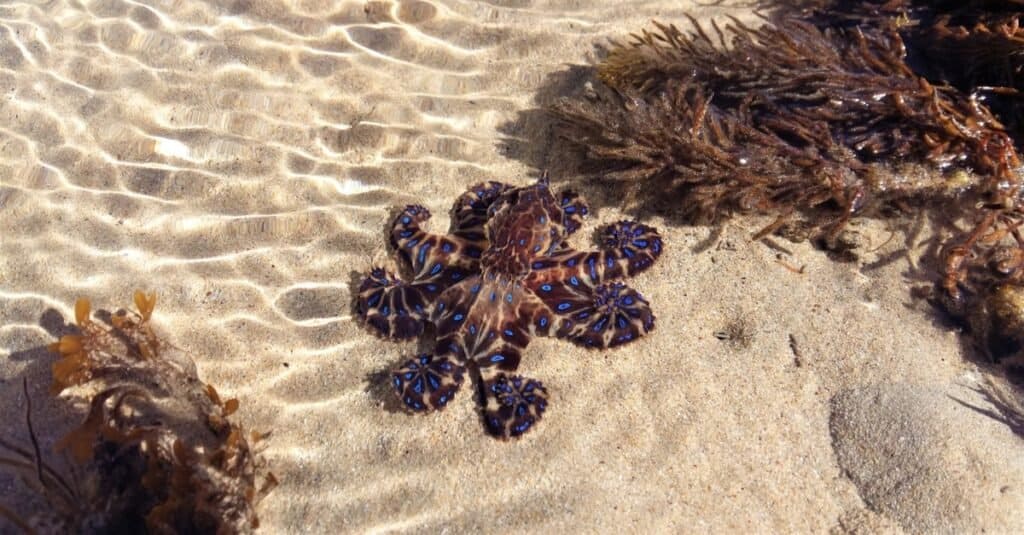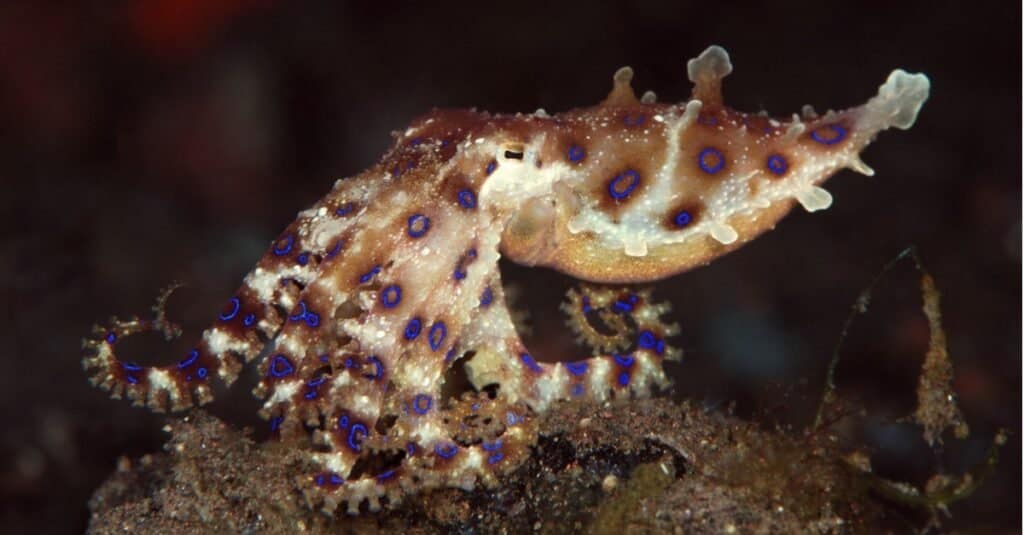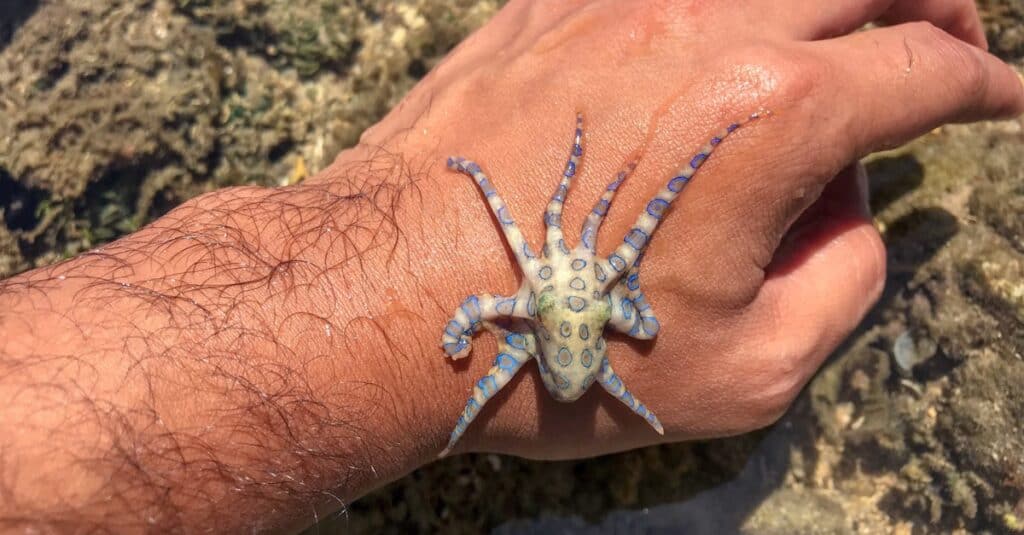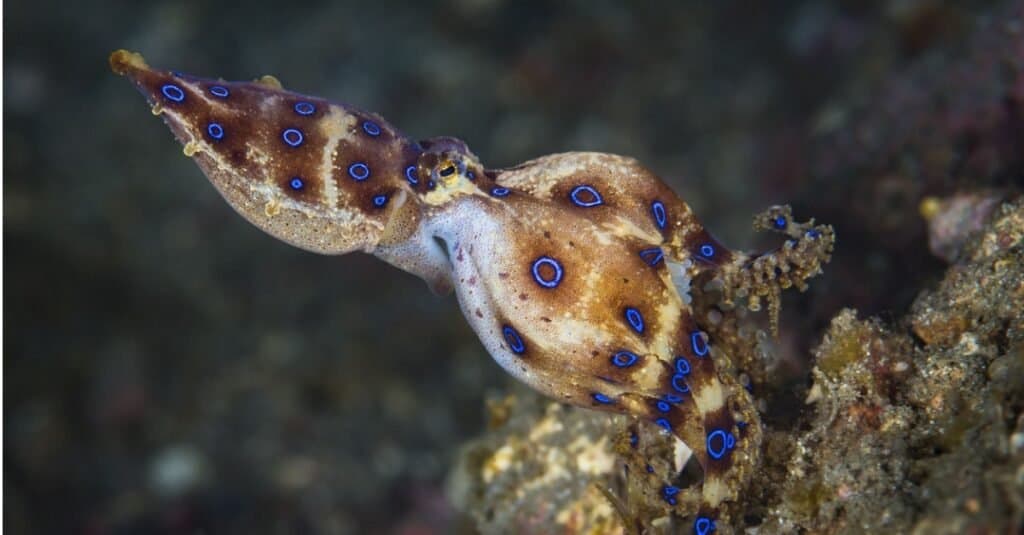The blue-ringed octopus is the world’s deadliest octopus due to the presence of tetrodotoxin, which paralyzes the victim. This unique octopus lives in the warm, shallow waters off the coast of Australia, Japan, the Philippines, and Vanuatu. Human interaction with a blue-ringed octopus is almost always accidental. The blue-ringed octopus injects the venom via a venomous bite. Sadly, the sting is frequently fatal. Therefore, it is important to avoid getting close to or handling this octopus.
Appearance

The blue-ringed octopus has brilliant blue rings on its body and arms.
©K.Pock Pics/Shutterstock.com
The appearance of this octopus can be attractive, and it’s unbelievable that its sting can pack such a punch. Blue-ringed octopi rarely exceed 12 cm in length. Their bodies are yellow, brown, and grey, which helps them blend in. Deep brown blotches and stripes are visible on the arms. The brilliant blue rings on their bodies and arms contribute to their name and appeal. These rings are an example of aposematism, a behavior in which animals use bright colors to scare away predators. Unlike other aposematic species such as poison dart frogs and velvet ants, which display their vibrant colors constantly, blue-ringed octopi reveal their dazzling colors only when threatened.
Color Changing Ability
Thousands of chromatophores are beneath the skin of octopi. These are one-of-a-kind cells that can change color instantly. Blue-ringed octopi use these cells with iridophores, a specific type of light-reflecting chromatophore that gives the blue rings their iridescence, to put on a display when threatened.
When frightened or attacked, blue-ringed octopi rapidly change color. They exhibit their blue patterns on a yellow or cream-colored substrate with dark pigmented cells beneath the rings, emphasizing their hue. The good news is that despite the extreme toxicity of a blue-ringed octopus bite, just three documented deaths have occurred over the last century – two in Australia and one in Singapore. This is most likely because blue-ringed octopi can use their chromatophores to blend in. They spend a lot of time hiding in cracks, avoiding predators.
Geographic Location

The blue-ringed octopus lives all over the world.
©iStock.com/DiveIvanov
From the Sea of Japan to Vanuatu, this deadly octopus resides all over the world. Tiny blue-ringed octopi dwell in tidal pools, seagrass, and algae beds, as well as on coral reefs and stony seafloors. At a depth of 50 meters, they live in the intertidal flats. They are nocturnal predators that typically come out at night to feed on small crustaceans and fish.
Eating Habits
Tiny crabs and shrimp are the primary prey of the blue-ringed octopus during the day, but it will eat mollusks and small fish in the evening if it manages to capture them. Using its tentacles, the octopus encircles and engulfs its prey. To deliver its poison, it has a beak that punctures its victim. With its beak, the octopus injects the venom into crabs, prawns, and small fish by pecking through their exoskeletons. When the prey is completely motionless, it will use its beak to scavenge for meat.
Danger to Humans

The blue-ringed octopus has a bite that can be fatal within minutes.
©Mark Anthony Sefuentes/Shutterstock.com
When frightened, this little octopus produces vivid blue rings as a warning that it is going to bite. The venom of the blue-ringed octopus contains a potent nerve poison for which there is no antidote. Within minutes, a single bite can be fatal. A blue-ringed octopus cannot be eaten. Its toxin remains poisonous even after being cooked at a hot temperature. It can cause serious poisoning or death if consumed. That’s one deadly octopus!
Lifespan

The blue-ringed octopus lives an average of two to three years.
©iStock.com/RibeirodosSantos
The species has an average lifespan of two to three years. Their modest size, five to eight inches, and docile demeanor do not denounce their danger. The venom of the blue-ringed octopus is a potent neurotoxin called tetrodotoxin. This is extremely hazardous to humans, and therefore, people should avoid any handling of this creature.
Wrapping Up the Blue-Ringed Octopus
Blue-ringed octopuses are among the most dangerous animals in the ocean. The blue-ringed octopus injects venom by biting. However, only a few people have died due to a blue-ringed octopus. When not antagonized, these octopi stay in the background and avoid conflict. Most of the time, encountering a blue-ringed octopus is an accident. Avoid handling this octopus because of the presence of tetrodotoxin in its sting, which paralyzes victims.
The photo featured at the top of this post is © iStock.com/Subaqueosshutterbug
Thank you for reading! Have some feedback for us? Contact the AZ Animals editorial team.






